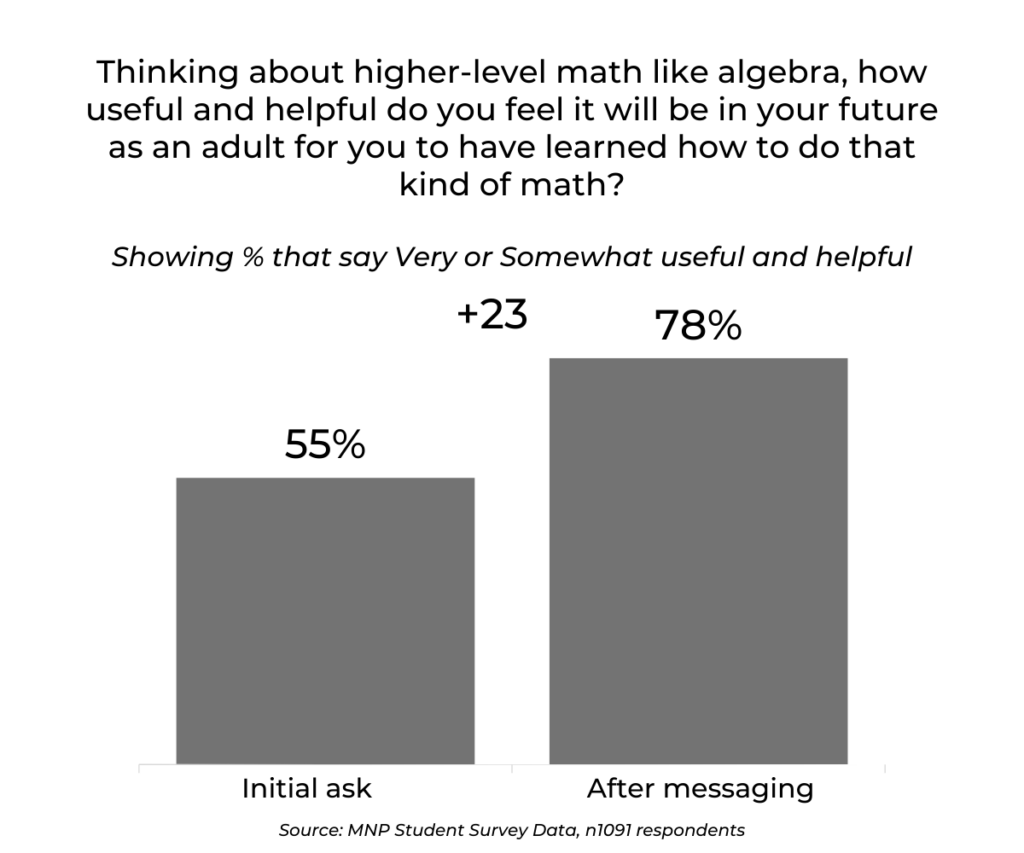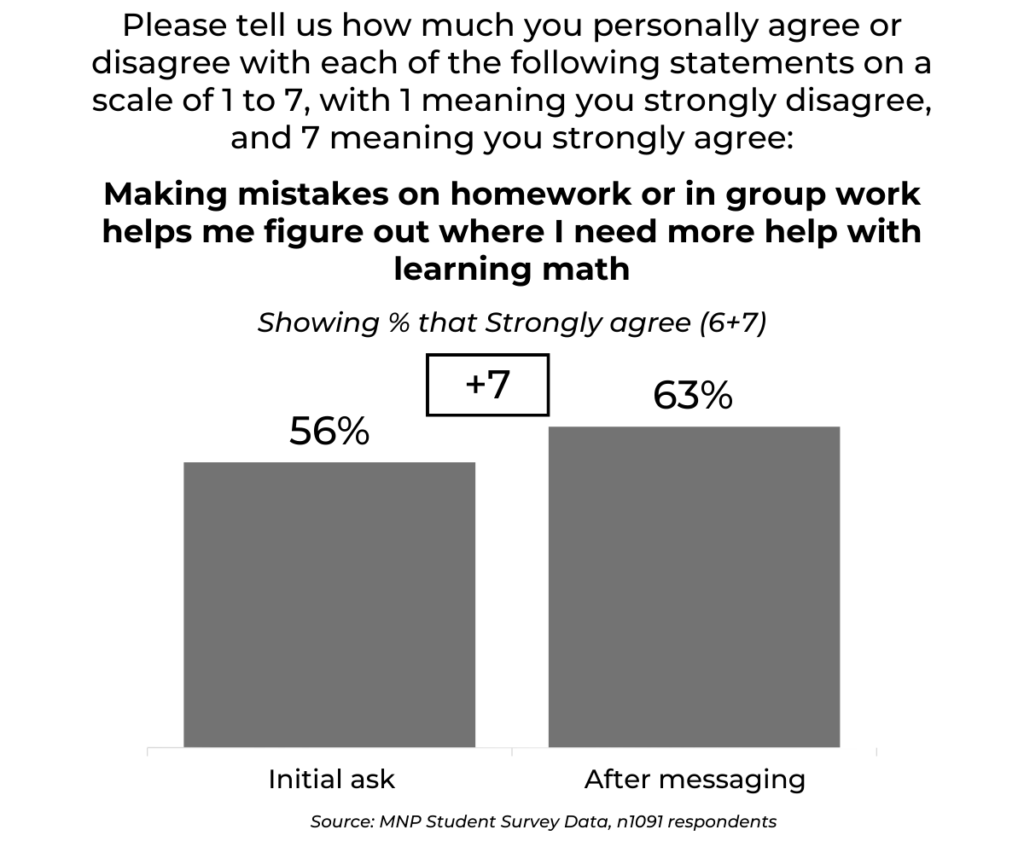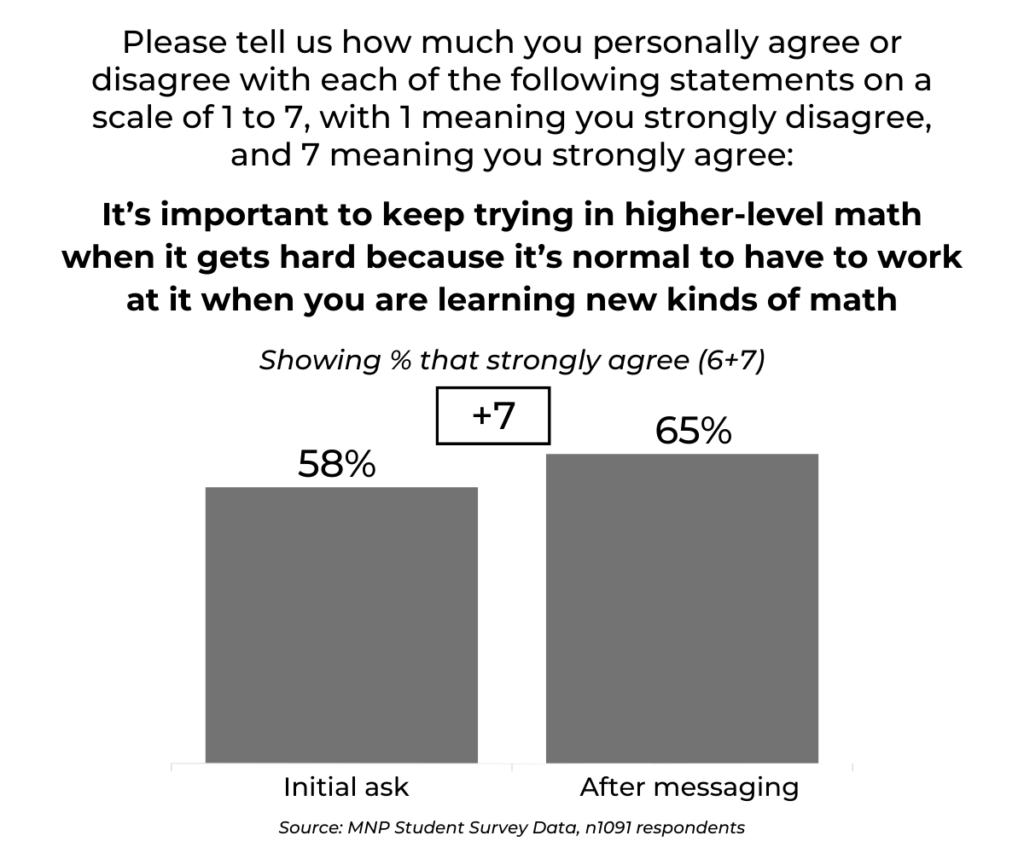Messaging Recommendations
Audience: Students
The following messaging recommendations are informed by insights and findings from The Math Narrative Project. They provide guidance on how to effectively communicate with 6th to 10th grade students, parents*, and math teachers. Recommendations include guidance about specific framing, language, and stories that research participants found persuasive. They also provide insight into what types of messengers are best positioned and most effective in delivering a particular message.
The recommendations on this page are intended for people communicating directly with students. They are meant to support professionals, including teachers, instructional designers, district leaders, curriculum developers, content developers, and others who work to engage, motivate, and enable students to learn math.
*Throughout this website, the research team uses ‘parent’ to refer to both parents and guardians.


Recommendation #1
ELEVATE STUDENT AGENCY: Messaging should elevate student agency and center students’ emotions and experiences, which are critical to their math learning.
Why is this important? Students are less motivated to persist in learning math when teachers and parents* ignore students’ agency in math learning.
*Throughout this website, the research team uses ‘parent’ to refer to both parents and guardians.
IN STUDENTS’ OWN WORDS:
Position students as active participants in their math learning with messages that:
- Feature peers who describe their own experiences learning math and how their choices have enabled them to persist when math gets difficult.
- Elevate near-peer student messengers (an older student close in age) who have a range of experiences and feelings about math to help students relate more positively and quickly to the message.
Note: Students often respond well to messengers regardless of whether they match their own racial and gender identity; they are more likely to connect emotionally to those who share similarities in their lived experiences and context.
Messages about math learning should balance honesty with agency.
- For example, messages should be honest about the aspects of students’ math education over which they have little or no control (e.g., the stakes of making a mistake on a test, state-wide testing, a district requirement that they take certain classes to graduate) and also emphasize the parts of their lives over which they do have control (e.g., asking for help from a teacher, finding resources online, getting help from a friend).
- The messenger begins by talking about how she chose to ask for help, modeling taking action to improve one’s math learning.
- The messenger affirms that confusion is a common feeling young people have when learning math, while also showing that students have a choice over what to do when they feel that confusion.
It [the video] encourages you to go and ask for help if you don’t understand something.
Hispanic Male, Student, California
Source: MNP Student Survey Data, n1091 respondents
Listening to the other students talk about how we should ask for help and that’s why teachers are there just gave me that much more confidence.
White Male, Student, California
Source: MNP Student Survey Data, n1091 respondents

Recommendation #2
ACKNOWLEDGE REAL-WORLD CONTEXT: Empathize with students, teachers, and parents by acknowledging and naming the real-world challenges they face.
Why is this important? Students’ experiences learning math are impacted by what happens both inside and outside of the classroom.
IN STUDENTS’ OWN WORDS:
Acknowledge the realities students face. Examples reported by research participants include:
- Help is sometimes unavailable when students seek it
- Having a bad math teacher for one or more classes can interfere with math learning
- COVID learning interruptions and knowledge gaps
- Teachers’ increasing reliance on online learning and the difficulties for some students to get timely help when they need it
- Issues students are experiencing outside of the classroom
- Heightened sensitivity towards social dynamics and fear of embarrassment during adolescence
- Large class sizes/high student-to-teacher ratios
- Pacing of teaching and emphasis on testing and standardized testing outcomes
Sample video message of Hispanic female near-peer messenger tested with student audience
- This messenger shares a negative learning experience over which she had no control. This shows students that the message is meant for them, even though things beyond their control also impact their learning.
- When she pivots and shares how she was able to find help despite having many substitute teachers, it shows students it is possible to find help outside of school and helps students feel more hopeful about their ability to impact their own math learning.
I relate because I had to learn myself when things got hard.
Black Female, Student, Florida
Source: MNP Student Survey Data, n1091 respondents
I felt like I could relate to her, especially on the aspect of having so many substitutes.
Hispanic Male, Student, New York
Source: MNP Student Survey Data, n1091 respondents

Recommendation #3
ACKNOWLEDGE EMOTIONS IN MATH LEARNING: Normalize the emotional nature of learning math, and provide examples of how negative emotions can be reinterpreted.
Why is this important? Students’ negative emotions around learning math can reduce their willingness to persist when learning math gets difficult. When frustration, stress, or feeling overwhelmed are particularly strong, students may be more likely to disengage completely.
IN STUDENTS’ OWN WORDS:
Acknowledge that mixed or negative emotions, like feeling frustration, being overwhelmed or being confused around learning math, are normal and shared by others.
- Share near-peer stories in which students describe the emotions they experience learning math.
- Affirm many students’ perception that learning math can feel hard and sometimes feels harder than other subjects.
Reframe negative emotions as an indication of a need to seek help and not as an indication of an inability to learn higher-level math (like algebra or above).
- Show how peers and near-peers who have had negative emotions learning math have moved from feeling overwhelmed to feeling they can and should get help.
Sample video message of Hispanic female near-peer messenger tested with student audience
- Here, the messenger talks about common negative feelings many young people have while learning math, helping them to recognize they are not alone and these emotions are normal.
- She also describes her own negative emotions and experiences learning math. She explains that she saw these emotions, not an indication that she is bad at math, but instead as a motivation to seek help.
- Hearing from near-peers who have felt negative emotions while learning math, and were able to persist in learning math despite those emotions, can help students feel hopeful about their own future math learning.
It totally fits the way I feel most of the time and gave me some good advice.
Hispanic Female, Student, Texas
Source: MNP Student Survey Data, n1091 respondents
I think something that was useful or helpful was when she said how she felt about math right in the beginning of the video and her experiences of being in math classes.
Black Female, Student, California
Source: MNP Student Survey Data, n1091 respondents

Recommendation #4
MAKE MATH RELEVANT: Deliver credible and motivational messaging on the relevance, value, and utility of higher-level math for students’ lives, desired careers, and futures.
Why is this important? Students often don’t believe higher-level math like algebra is relevant to their lives and therefore don’t feel motivated to persist when learning higher-level math feels hard.

Deliver credible messaging on higher-level math’s relevance, value, and utility for students’ lives and futures.
- Include examples of relevance that students understand, believe are real, and care about, such as: keeping your career options open; financial literacy; and having greater financial power so you don’t get scammed or cheated.
Alleviate heightened stress about learning math, by pairing messaging about relevance with messages that show students where and how they can get help, support, and resources.
- Employ varied messengers, including near-peers, teachers, and parents/other trusted adults.
Use different examples that resonate to different degrees with different young people:
- Examples should show how math is used in that specific instance.
- Examples should include a mix of concepts and applications so that students at different points in their math education can relate.
“Knowledge is power, and knowing higher-level math like algebra can help you protect yourself and your family from being scammed, more than just common sense alone. Some companies target Black or Hispanic communities or communities without a lot of money and try to charge high interest rates (like with payday loans). But if you understand higher-level math, you can make sure you and your family are not getting cheated or taken advantage of.“
Sample print message tested with student audience
Eighty-five percent (85%) of students in the survey report this is an excellent (40%) or good (46%) reason to keep trying to learn math, even if it gets hard. Notably, this message performs well across race and gender subgroups.
This message included several different examples of relevance that many youth find credible, including:
- Keeping your future career options open (e.g., Math helps you have more choices when and if you ever need to pivot)
- Helping you understand and choose between loans and interest rates
- Helping prevent you or your family from getting scammed or cheated
I underlined, ‘but if you understand higher level math, you can make sure that you and your family aren’t taken advantage of.’ Personally, I just want to make sure that my family doesn’t have that happen to them because I do care about my family, and [knowing] higher-level math can help protect them.
Hispanic Female, Student, New York
Source: MNP Student Qualitative Research

Recommendation #5
AFFIRM THE VALUE OF MISTAKES: Normalize making mistakes as an important and valuable part of learning, including learning math.
Why is this important? Students often experience negative emotions like frustration, embarrassment, and shame when making mistakes in the context of learning math, which can cause them to disengage or doubt their capability.
IN STUDENTS’ OWN WORDS:
Normalize making mistakes as an important and valuable part of learning.
- Remind students that most people make mistakes when learning something new.
- Draw parallels to learning other subjects or skills, including sports, gaming, music, and other activities that students enjoy and feel positively about.
- Use messages from teachers and near-peers to help ease students’ negative feelings about making mistakes.
- Be honest that mistakes carry different consequences in certain contexts, like homework or in the classroom; failing to acknowledge that mistakes on tests are higher stakes can undermine the credibility of the messaging.
Affirm that making mistakes is not a reflection of a student’s overall capability or potential but rather an indication that you need more help or support.
- Include messaging that encourages asking questions and seeking support.
- The first messenger normalizes mistakes and even says they’re “expected”. He then makes the connection to learning a different skill (an instrument) to remind students of what they already know: it’s normal to make mistakes when learning a new skill.
- The second messenger names the fear of being wrong, which is familiar to many students and makes the message more relatable. The messenger then talks about how mistakes can be helpful when you use them as part of the learning process.

Recommendation #6
ENCOURAGE HELP-SEEKING: Build student confidence to seek the help they need to learn math and equip parents and teachers with messaging that supports and encourages students to seek out help.
Why is this important? Students often feel that asking questions or asking for help can feel embarrassing and means they are worse than their peers at learning math or that they are not good at math.
IN STUDENTS’ OWN WORDS:
Encourage students to recognize that asking questions is a valuable part of the learning process and that everyone has questions at some point in their learning.
- Share stories of students who demonstrate and model confidence and have the agency to ask questions in and out of the classroom.
Take the stigma out of asking questions during math learning:
- Convey that everyone needs to ask questions when they are learning new things, with messages such as “questions are part of understanding new ideas.”
- Utilize teacher messengers who model supportive responses to students’ questions.
- Employ near-peer messengers who can share stories about how they came to recognize the value of asking questions.
- Acknowledge that fear of embarrassment and social anxieties are a normal part of adolescence and may be present for many students.
Share stories of students who asked a question despite their concerns of being embarrassed and had a good experience. Or share instances in which students found ways to ask a teacher for help privately or to ask their peers.
Expand students’ perceptions of the places and people who can assist them with learning math.
- Include examples where students ask peers for help in class or after class and ask teachers for help during or after class or privately rather than in front of the whole class.
- Provide students with access to a variety of tangible, realistic, free, and low-cost resources to support math learning, including online resources, help from adults who are not teachers, or help via other school supports such as tutors.
- The near-peer begins by normalizing the need to ask for help, and also names the embarrassment that many students feel when they have questions and the nervousness they can feel asking teachers for help.
- Sharing the positive outcome of what happened after she asked for help can help to instill a sense of hope in other students–that if they ask for help they also might be able to get help that works for them.
The [person] in the video struggled with math as I often do. She felt asking for help helped. Online videos seemed to help her too. I have begun to ask for help as she did with peers.
Hispanic Male, Student, Texas
Source: MNP Student Qualitative Research
I think if I was asked [for advice] before I came here…I wouldn’t have said to try and ask too many questions because it’s kind of embarrassing…but now that I watched some of the videos and I’ve heard from you guys…I think now that one advice [for other students in math] would be to ask more questions. And even me, I’ll try to ask more questions in my class.
AAPI Male, Student, California
Source: MNP Student Qualitative Research

Recommendation #7
REFRAME STRUGGLE AND CAPABILITY: Reframe struggle from a sign of lacking capability to a sign of needing support.
Why is this important? Students who struggle when learning math interpret it as a sign of their capability, and it discourages them from persisting in learning higher-level math.
IN STUDENTS’ OWN WORDS:
Normalize the experience of struggle while learning math by acknowledging that struggle while learning is a common experience and not inherently a sign that you’re bad at something.
Reframe struggle from a sign of lacking capability to a sign of needing support.
- Affirm that persisting through struggle with support is important for building stronger math skills.
- Encourage students to reflect on other parts of their lives that they enjoy (ex: sports, gaming, music, dance, etc.) where they have already demonstrated that they can engage with struggle in positive ways.
Use messengers, including adults and near-peers, who share their own experiences of struggle and describe how they overcame this and what resources helped them. These messengers can validate students’ experiences of struggle, model how to reinterpret struggle, and point students toward resources that can help them.
“You may get frustrated with math if you don’t get the right answer right away. But you can’t get better if you don’t make mistakes. It’s like exercise – if you get sore muscles or get out of breath, it just means you’re doing something more challenging than what your body is used to. And you can’t get stronger without trying something more challenging.”
Sample print message tested with student audience
- This message normalizes feeling frustrated when struggling to learn new concepts and making mistakes.
- Then it reframes struggle and difficulty as something valuable by comparing it to the process of becoming physically stronger, thereby conveying the idea that struggle can make you stronger in the long run.


